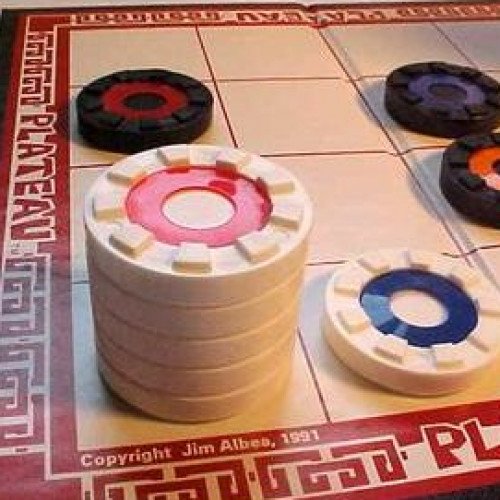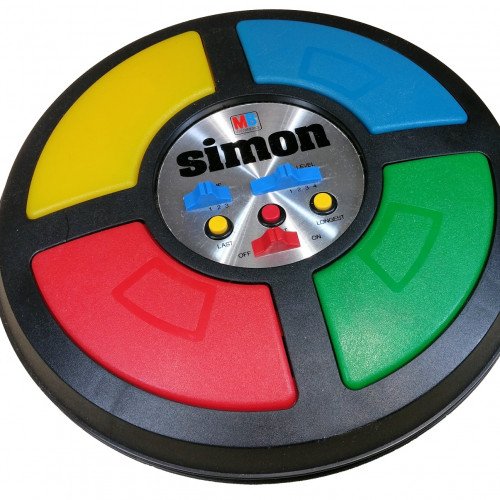PLATEAU VS SIMON

PLATEAU
Plateau is a two-player abstract strategy board game invented by Jim Albea. The game was developed over a two-year period culminating in its present form on May 12, 1986. The original name for the game was Pinnacle, but it was discovered that an older board/card game had that name, so around 1989 the name was changed to Plateau. From the 1980s through the 1990s Plateau was played at Science Fiction conventions mostly in the Southeastern United States. From the 1990s to the present, the game is played live at an online game site and via email. In 1997 a computer implementation of the game was created which facilitates email play and has a computer robot. Onboarding is adding one new piece to the play. This new piece can be placed anywhere that doesn't directly harm an opposing piece. For instance, you can onboard to any blank square or on top of any of your own pieces. The majority of Plateau moves are onboards. Instead of Onboarding or Moving, a player can choose to spend his turn exchanging prisoners. Prisoners are exchanged using the point values of the pieces. A simple value-for-value system is used. Since the pieces range in value from 1 point (for the mute) to 21 points (for the Ace) there are usually several combinations and options available for the players. The player initiating the exchange selects the pieces he wishes to exchange. These pieces will all add up to some point value. The responding player then has four options depending on the point values of the prisoners that he holds.
Statistics for this Xoptio

SIMON
Simon is an electronic game of memory skill invented by Ralph H. Baer and Howard J. Morrison, working for toy design firm Marvin Glass and Associates, with software programming by Lenny Cope. The device creates a series of tones and lights and requires a user to repeat the sequence. If the user succeeds, the series becomes progressively longer and more complex. Once the user fails or the time limit runs out, the game is over. The original version was manufactured and distributed by Milton Bradley and later by Hasbro after it took over Milton Bradley. Much of the assembly language code was written by Charles Kapps, who taught computer science at Temple University and also wrote one of the first books on the theory of computer programming. Simon was launched in 1978 at Studio 54 in New York City and was an immediate success, becoming a pop culture symbol of the 1970s and 1980s. Ralph H. Baer and Howard J. Morrison were introduced to Atari's arcade game Touch Me at the Music Operators of America (MOA) trade show in 1976. Baer said of the product, "Nice gameplay. Terrible execution. Visually boring. Miserable, rasping sounds." The prototype built by Baer used the low cost Texas Instruments TMS 1000 microcontroller chip, which was in many games of the 1970s. Lenny Cope, who was one of Ralph H. Baer's partners, programmed the core of the game, titled Follow Me at the time. Baer developed the tones of the game, inspired by the notes of a bugle. When they pitched the demo, an 8-by-8-inch console, to the Milton Bradley Company the name of the game was changed to Simon. Simon debuted in 1978 at a retail price of $24.95 (equivalent to $98 in 2019) and became one of the top-selling toys that Christmas. U.S. Patent 4,207,087: "Microcomputer controlled game", was granted in 1980. Milton Bradley soon capitalized on the original with both the smaller-sized Pocket Simon and the expanded, eight-button Super Simon. Many variants of Simon have been made since Hasbro acquired Milton Bradley in the 1980s, building on the possibilities offered by advances in technology. The original Super Simon was reinvented in the late 1990s as a hexagonal unit with six buttons. 2000 saw Simon Squared (or Simon2), a unit with the four traditional buttons on one side, and a set of eight smaller buttons on the other. In 2004, Hasbro released the Simon Stix. The game features two electronic sticks (modeled after drumsticks), an emphasis on the musical part of the game, and features four levels of play. In 2005, Hasbro released Simon Trickster (also known as Simon Tricks in Europe and in the UK, and as Simon Genius in Brazil), which features four game modes, in a similar fashion to another Hasbro game, Bop It, and colored lenses instead of buttons. "Simon Classic" mode plays up to 35 tones(notes). "Simon Bounce" is similar to "Simon Classic", but instead the colors of the lenses change. "Simon Surprise" is one of the most difficult games in the unit. Every lens becomes the same color and the player has to memorize the location. "Simon Rewind" requires the player to memorize the sequence backwards. During each game, the player is paid a compliment after a certain number of tones completed. On reaching five and eleven tones, the computer will randomly choose "Awesome!", "Nice!", "Sweet!" or "Respect!". On reaching 18 tones, the game will play a victory melody three times. On reaching the ultimate 35 tones, the game will play the victory melody again and will say "Respect!". If the player fails to memorize the pattern or fails to press the right color within the time limit, the game will play a crashing sound and the game will say "Later!".